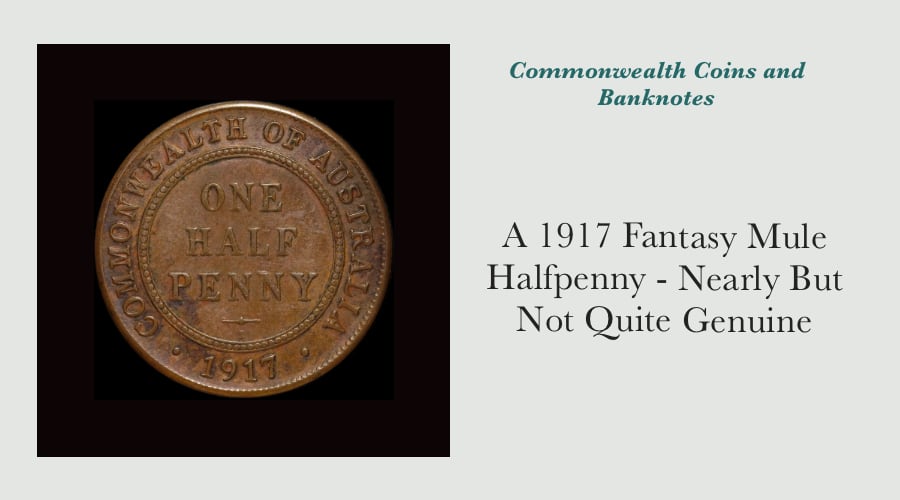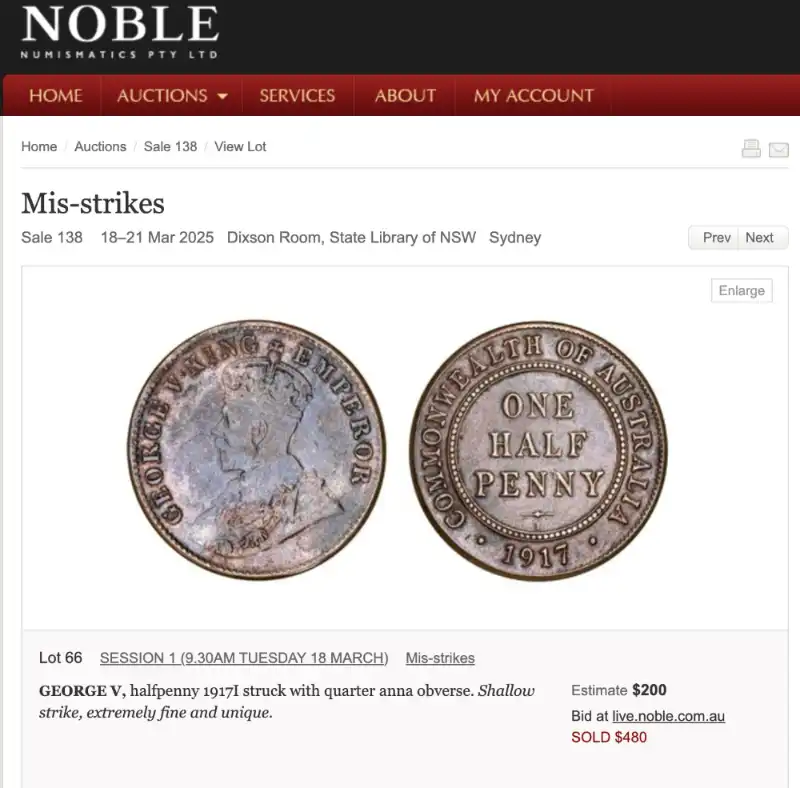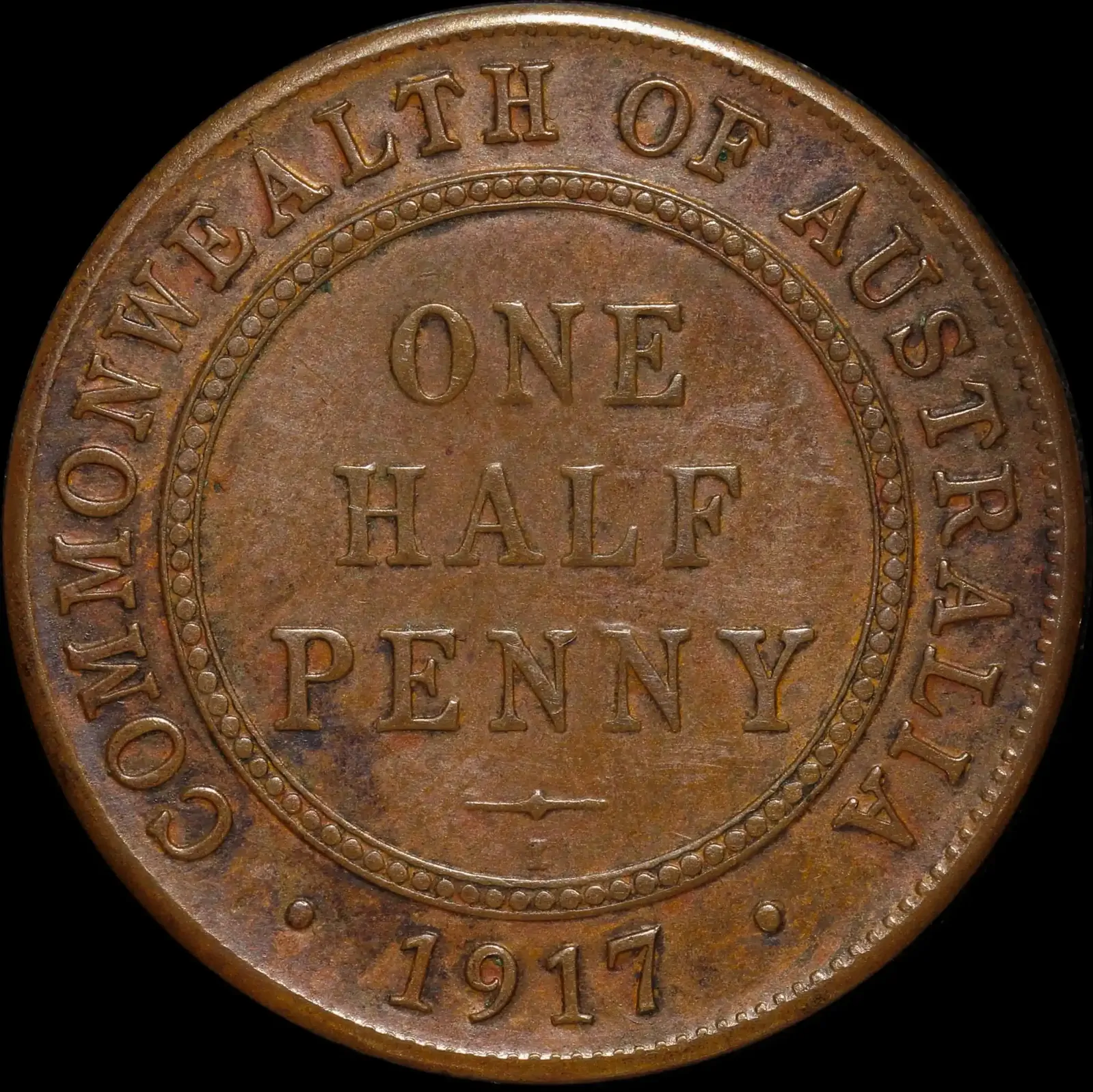A 1917 Fantasy Mule Halfpenny - Nearly But Not Quite Genuine

When I attend a numismatic auction, my focus is generally pretty dialled-in on items we'll be able to buy and resell to customers at a fair price. Very seldom do I come across something that really appeals as a side project, lot 66 in Noble Numismatics Auction 138 (March 2025) was an exception.

Noble Numismatics Lot 66, Sale 138
Image Source: Noble Numismatics
The lot description read: "GEORGE V, halfpenny 1917I struck with quarter anna obverse. Shallow strike, extremely fine and unique. Ex Pridmore Collection with his ticket stating 'Fabrication?'"
Major Fred Pridmore
Major Fred Pridmore (1914 - 1980) was a British numismatist, he wrote several definitive books on the coinage of the British Commonwealth and was an unequivocal numismatic expert - I have perhaps half a dozen of his books in my library. If he didn't declare this coin genuine, then chances were it wasn't. The fact that the term "Fabrication" on his ticket was framed as a question intrigued me though, it led me to believe he hadn't completed his research into the coin.
Counterfeit mules or double-sided coins are concoted by bonding the halves of two different coins together. That post-minting effort is generally evident either by a seam down the middle of the edge of the coin (the simplest and most obvious method) or by machining out a section of one side of the coin, then inserting a cut section of another coin into that blank space (a more challenging method but one that bypasses the test of those who check the rim).

Fred Pridmore
I examined the coin with my magnifier and couldn't see a seam running parallel around the edge, nor could I see a seam running on the inside of the rim on either side. That meant it was a better effort than 99.99% of attempts at fraud I've seen.
Lot 801 in Part II of Pridmore's collection was for a bulk lot of 15 different items, it included the following statement:
"...a copy India, Half-Anna/Halfpenny, 1917 mule, made by S. G. M. Adams of Leeds (see Glendinings, 9th November, 1978, lot 516);"
At that time, I didn't know who SGM Adams of Leeds was, nor did I know whose collection was sold by Glendinings (of London) on 9th November, 1978. Before the advent of the internet and the digitisation of printed documents, a numismatic detective needed an extensive library and an extensive network of similarly-minded numismatists happy to exchange information. The internet makes light work of such investigation these days, as a lot of material can be found by using lateral thinking and internet searching.
In a short space of time, I was able to determine that the November 1978 Glendinings catalogue was for the sale of the collection of Harold J Armstrong.
Harold J Armstrong
I found out that Mr Armstrong lived at Cookridge, Leeds (United Kingdom), was born in Australia and moved to England as a young boy.
Armstrong served in the Leeds Rifles and the West Yorkshire Regiment in World War I, and while recovering from leg injuries received at Arras, he became interested in coins. He joined the Yorkshire Numismatic Society on 21st June 1924, served as president in 1930-1, was the Society’s silver medallist in 1939 and was appointed to honorary membership in 1968.
The description of Lot 516 in the Harold Armstrong Collection (sold by Glendining on November 9th 1978) included the following statement:
"Yorkshire, Tokens, Checks and Medals, in A (2), AL, etc. (43) and plastic (66, mostly relating to transport); S. G. M. Adams of Leeds, Tokens, etc. (52), mostly in WM. Latter extremely fine, others mostly very fine."
Now if I read that lot description, there was no specific statement referring to a 1917 Halfpenny, so I cooled off on the veracity of Pridmore's supposition that the item was a fantasy (only temporarily as it turned out).
S.G. (Myers) Adams
With a bit more lateral thinking and internet sleuthing, I determined that S.G. (Myers) Adams was a die sinker and dental mechanic based in Leeds (United Kingdom). A blog article for the British Numismatic Society advises: "Myers Adams was a die sinker and dental mechanic, based in Leeds. He was numismatically active in the 1960s and 70s. His engraving skills were exceptional, producing freehand dies and striking a Winston Churchill memorial medallion within a week of the announcement of Churchill’s death. Adams died in Leeds, c.1996."
SG Myers Adams seems to have been on the outskirts of the numismatic trade - there is very little evidence of his body of work online. I noted one article that attributed the production of several "spurious" countermarked internment tokens to him, another credited him with the manufacture of "spurious" countermarks on a silver token dated 1811, also from the Isle of Man. When a die sinker is linked with "spurious" items, then the abductive reasoning test involving a duck comes into play: "If it looks like a duck, swims like a duck, and quacks like a duck, then it probably is a duck".
The above timeline indicates this fantasy "mule" was struck in Leeds by SG Myers Adams for Harold Armstrong before Armstrong died in 1978. It was then acquired by the celebrated numismatist Fred Pridmore, who at least had enough faith in the possibility of it being genuine that he paid money for it. The note "Fabrication?" on his collection card indicates he hadn't definitively concluded that it was a fantasy piece.
Reverse |
Obverse |
 |
 |
Technical Characteristics
Country |
Denomination |
Ruler |
Period |
Diameter |
Weight |
Thickness |
Composition |
Obverse Legend |
| Australia | Halfpenny Fantasy Mule | George V | 1917 | 25.65mm | 7.19g | 1.72mm | Not Tested | GEORGE V KING EMPEROR |
| Australia | Halfpenny | George V | 1911-1936 | 25.50 mm | 5.67 g | ~1.7 mm | Bronze ~97 % Cu, 2.5 % Zn, 0.5 % Sn | GEORGIVS V D.G. BRITT: OMN: REX F.D. IND: IMP: |
| British Honduras | 1 Cent | Edward VII / George V | 1904-1909, 1911-1936 | 29.00 mm | ~9.45 g | ~1.6-1.7 mm | Bronze 95 % Cu, 4 % Sn, 1 % Zn | Edward VII: EDWARD VII KING AND EMPEROR; George V: GEORGE V KING AND EMPEROR |
| British India | ¼ Anna | George V | 1912-1936 | 25.40 mm | 4.85 g | ~1.35 mm | Bronze (Cu-Sn-Zn; ~95 % Cu typical) | GEORGE V KING EMPEROR |
| Canada | 1 Cent | George V | 1912-1920 | 25.40-25.50 mm | 5.67 g | ~1.6 mm | Bronze 95 % Cu, 4 % Sn, 1 % Zn | GEORGIVS V DEI GRA: REX ET IND: IMP: |
| Hong Kong | 1 Cent | George V | 1911-1936 | 28.00 mm | ~7.10 g | ~1.7 mm | Bronze ~95 % Cu, 4 % Sn, 1 % Zn | GEORGE V KING AND EMPEROR |
| Newfoundland | 1 Cent | George V | 1904-1909, 1913-1936 | 25.53 mm | 5.67 g | ~1.5 mm | Bronze 95 % Cu, 4 % Sn, 1 % Zn | GEORGIVS V D.G. REX ET IND: IMP: |
| Straits Settlements | 1 Cent | George V | 1911-1936 | 28.50-28.80 mm | ~9.33 g | ~1.6-1.7 mm | Bronze 95 % Cu, 4 % Sn, 1 % Zn | GEORGE V KING AND EMPEROR |
| United Kingdom | Halfpenny | George V | 1911-1919 | 25.48 mm | 5.67 g | ~1.3 mm | Bronze ~95.5 % Cu, 3 % Sn, 1.5 % Zn | GEORGIVS V DEI GRA BRITT OMN REX FID DEF IND IMP |
Reviewing the technical characteristics of this fantasy mule halfpenny with a table listing the characteristics of the Australian Halfpenny and the Indian Quarter Anna shows that they diverge in only one meaningful way from the characteristics we'd expect of a genuine mule Halfpenny.
While the diameter and thickness are within expected tolerance, the weight is around 27% higher than it should be. This indicates the planchet used is neither that of an Australian Halfpenny, nor of a Quarter Anna of British India.
Comparing the technical characteristics with those of a range of other copper British Commonwealth coins struck during the same period indicates the planchet could not be one of those coins either.
Visual Characteristics
Reverse:
The relief of the detail in the legend across the reverse is marginally lower than that on a genuine coin. There are very minor but important differences in the letters "TR" of "AUSTRALIA", while the denticles around the reverse are either completely missing or are shorter than should be expected on a genuine coin.
Obverse:
As with the obverse, the denticles around the perimeter of the obverse are either completely missing or are shorter than should be expected on a genuine coin. The letters in the legend are not as precisely struck as we'd expect to see on a genuine coin struck under correct pressure, nor is the relief of the portrait of the King.
After taking all of the above considerations into account, I can only conclude that this fantasy mule halfpenny was yet another "spurious" product concocted by SG Myers Adams, this time for the collection of his fellow Leeds resident, Harold Armstrong.
Having been born in Australia, Armstrong may have been keenly aware of the international news of the discovery of the fabled 1916 Mule halfpenny in July 1965. If the mule were a fantasy simply to be held in his own collection, it is a testament to the tenacity of Fred Pridmore that he located it in a bulk lot of completely unrelated tokens in the estate sale of Armstrong's collection. It is curious that for all of Pridmore's tenacity and thirst for knowledge, he didn't definitively conclude that it was an unofficial fantasy.
It remains a tangible response to the news celebrating the discovery of the 1916 Mule Halfpenny, breathlessly described as being “the biggest find in coin history, and one of the most valuable”.
Comments (4)
good and spurious.
By: Jonathon de Hadleigh on 17 November 2025Quite fascinating and a good read about a spurious piece, thank you for publishing this and informing me , as I do enjoy such pieces, Jonathon.
Cheaper just to use the real coin
By: Tom Menzies on 9 November 2025From the description above about making 'mules' it seems a lot of time, effort, material and machinery wear and tare, went into their manufacture. I would have been cheaper just to use the real coin. This is the first time I have read about 'mules', so I thank you for your time and effort.
Mules
By: Brian Kirton on 2 November 2025Very good research that lead to a very interesting article on a 1917 fabrication mule halfpenny. Congratulations on the article. We never stop learning, it is a lifelong journey.
Mule Train!
By: Tony Butz on 2 November 2025A fascinating story. Thanks for taking the trouble to write it up. _ Tony